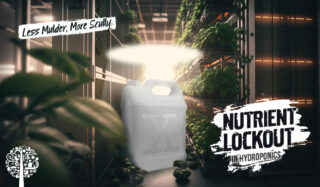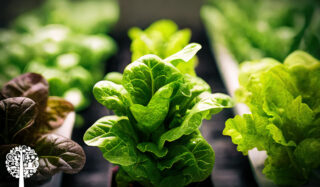Everest Fernandez takes a real-world look at the problem of “nutrient lockout” in recirculating hydroponics systems.

Nutrient lockout sucks.
Indoor hobby growers typically pay a lot for their hydroponic nutrients, whether in one bottle, two, three, or four—or as bags of dry powder. The common notion or expectation among growers is that, in return for all this financial outlay, the headache of consistently achieving optimal nutrition for our plants has been taken care of by some diligent lab coat-wearing formulation chemist on a light industrial estate somewhere. All the work that remains is measuring each part, mixing, stirring, adjusting pH, and everything should be balanced—all the mineral elements your plants could desire are in the solution.
More often than not, everything will run smoothly—especially if you have a good water source (the most often overlooked “additive”) and start at just a quarter or half of the full-strength recommendation. But sometimes, it’s anything but plain sailing.
From stunted growth, deformed leaves, and interveinal chlorosis to necrotic spots, leaf curl, and burnt leaf tips and margins, this is not the “convenience” you paid for.
Bad batch? It’s tempting for novices to scapegoat the nutrient brand as it absolves the grower of any responsibility—but, after visiting more than a few nutrient factories, I can attest that it’s improbable they messed up—especially if you’re buying from a reputable manufacturer with a raft of quality control procedures in place. Your grow store has heard it all before too. At best, you’ll be politely questioned about your growing environment, media, water source, and irrigation practices and leave with your tail between your legs.
Understanding Nutrient Lockout
Nutrient lockout is when essential elements become unavailable or inaccessible to plants, despite their presence in the nutrient solution. It is essential to clarify that lockout does not imply a lack of nutrients; rather, it indicates factors that prevent nutrient uptake and utilization. Several factors contribute to nutrient lockout in hydroponics, including pH-induced precipitation, nutrient imbalances, and salt buildup in the substrate.

pH-Induced Precipitation
Precipitation refers to an element forming an insoluble compound and dropping out of the solution. Remember, for any element to be taken up by plants, it needs to be dissolved. The solubility of specific nutrients is directly affected by the pH of the nutrient solution and growing media (if used). Dust off your hydroponics textbooks, and you may find iron, zinc, and manganese cited as examples of elements that become less available in alkaline solutions (high pH), but this refers to relatively cheap ‘old school’ sulfates (iron sulfate, zinc sulfate, and manganese sulfate).
Modern hydroponic stock solutions typically use ‘chelated’ forms instead. Chelates are a chemical ‘cage’ that maintains availability while protecting the iron, zinc, or manganese from fluctuations in pH that would otherwise cause them to become insoluble.
Did You Know?
The three most popular chelates used in hydroponic nutrients are EDTA, DTPA, and EDDHA. Each chelated form offers distinct benefits and drawbacks. EDTA is cheap and offers’ entry level’ protection against precipitation. DTPA offers higher stability over a broader pH range compared to EDTA but can still undergo dissociation and lose its chelation capacity at higher pH values. EDDHA is the best-performing chelate in maintaining availability across the widest pH range, including alkaline conditions, but it’s also the most expensive. EDDHA also requires more agitation to achieve solubility.
If your nutrient manufacturer is really ‘sparing no expense’, look for EDDHA on the label.
These days, hobby growers using recirculating hydroponics systems are more likely to fall foul of pH-induced precipitation of calcium and magnesium—two highly reactive elements that often cause growers issues.
Remember, in recirculating hydroponics, the pH of the feed solution tends to rise over time; this is due to several factors, including the uptake of nutrients (plants tend to uptake positively charged ions more than negatively charged ions leading to an accumulation of anions and an elevated pH) and alkaline water sources. Even plant exudates, initially acidic, can turn into pH-rising carbonates and bicarbonates once microorganisms metabolize them. If you’re using beneficial biology in hydroponics systems, this is something to watch out for.
Both calcium and magnesium become less available in even slightly alkaline solutions (pH 7.5 or higher). As the concentration of hydroxide ions increases, calcium and magnesium ions are more likely to form the precipitates, calcium hydroxide, and magnesium hydroxide.
LED growers running warmer air temperatures in their grow rooms should consider chilling their nutrient solutions (around 66°F or 20°C is optimal) or positioning their reservoirs outside the grow room. Warmer air temperatures lead to warmer nutrient solutions which, in turn, are more prone to increased microbial activity, accelerated nutrient uptake, and increased breakdown of carbonic acid—all of which can speed up the rise in nutrient solution pH. To mitigate these inevitable temperature rises, use the largest size reservoir that is practical. Adding “moaaaarrrrr calmag” will typically lead to high nitrate levels … which brings me to …
Nutrient Imbalances
Imbalances in nutrient concentrations can also contribute to nutrient lockout. Excessive application of certain nutrients, such as potassium or phosphorus, can interfere with the uptake of other essential elements like calcium, magnesium, zinc, and iron. Maintaining a balanced nutrient solution is essential. Carefully follow recommended application rates and avoid overzealous use of additives—especially calmag and PK boosters. Regularly monitoring nutrient levels and adjusting the solution will help prevent nutrient imbalances and improve nutrient availability.

When topping up your reservoir, mix up a half-strength nutrient solution and top up with that, rather than adding water and applying extra nutrient products. Plants uptake nitrates, ammonium, phosphates, potassium, and manganese very quickly, whereas elements such as calcium and boron are taken up more passively and slowly, or at least proportionally, to transpiration rates. Over time, this can lead to an excessive supply of calcium and boron in the solution—especially for calmag lovers—which invariably antagonizes magnesium uptake, leading to the telltale interveinal chlorosis. Often, this leads inexperienced growers to add more calmag, exacerbating their magnesium lockout issue further.
Coco Coir and Potassium
Coco coir is an excellent growing medium, but growers must know its tendency to claw back calcium and dump potassium into your nutrient solution. If you repot your plants towards the end of the vegetative period and start using PK boosters too early, you could double-dose your plants with potassium and crowd out calcium. Finding plants exhibiting symptoms of calcium lockout is now a daily occurrence when browsing Instagram and other social platforms. Necrotic spots, leaf deformities, and weak stems are everywhere! Use a coco-specific nutrient formula and high-quality, double-buffered coco coir.
Managing pH and Temperature
In recirculating hydroponic systems, pH rises over time due to nutrient uptake and alkaline water sources. Increased air temperatures can exacerbate the rise in pH, leading to nutrient lockout. Growers should monitor and maintain the pH of the nutrient solution within the optimal range (typically 5.5 to 6.5) to prevent precipitation and ensure nutrient availability. Additionally, maintaining cooler nutrient solutions by chilling them to around 66°F (20°C) or positioning reservoirs outside the grow room can mitigate the effects of temperature-induced pH rise.
Salt Buildup in the Substrate
Improper irrigation practices can lead to the accumulation of salts in the root zone, impeding nutrient absorption. High salt concentrations cause water to move out of the plant roots, making it challenging for plants to uptake nutrients. Adjusting irrigation practices, such as employing appropriate watering volumes and frequencies based on the specific growing media (e.g., Rockwool or coco coir), can help mitigate salt buildup. Ensuring adequate runoff to remove excess salts from the root zone is vital for maintaining nutrient availability.
Final Thoughts
Nutrient lockout can pose significant challenges in hydroponic systems, affecting plant growth and productivity. By understanding the underlying causes and implementing effective nutrient management strategies, growers can mitigate the risks of lockout. Balancing nutrient concentrations, monitoring pH levels, managing temperatures, and adopting proper irrigation practices are essential for maintaining optimal nutrient availability and ensuring healthy plant development in hydroponic cultivation.
Ask your local grow store for nutrient products specifically designed for recirculating hydroponics.
GREYT article brother Everest!!!! Once again you come correct with some eye opening reassurance and reminders for this “overzealous” grow couple!!!
#greytful